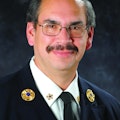The following topic is one of our dirty little secrets, like firefighters committing arson. I recently attended a meeting of top staff at a metropolitan fire department and I visited a firefighters' union office. At both places, the talk centered on an apparatus accident in Houston, TX, that occurred the day before. Accidents involving fire apparatus seem to be happening nationwide on an almost daily basis. There have been several accidents involving two pieces of responding fire apparatus colliding with each other in the past few months. Numerous firefighters were hurt and the apparatus severely damaged or destroyed. (For just one example, see the video posted at http://www.youtube.com/watch?v=G3uoVOOlT2s.)
There are numerous reasons for the accidents and no one is pointing a finger, but the facts and death-toll figures are staggering. According to the National Fire Protection Association (NFPA), from 1977 through 2007, a total of 3,826 firefighters died in the line of duty. Of those, 932 were killed responding to and returning from alarms. This accounts for approximately 20%-30% of the firefighters killed in the line of duty each year.
For responding fire departments to serve the public, mitigate the emergencies or extinguish the fires, they must arrive alive. Like the National Fallen Firefighters Foundation's motto, "Everyone Goes Home," we need to arrive and return in one piece. This is certainly one area in which the U.S. fire service can do a lot better. Enough is enough! See Mike Wilbur's column on page 34 for details.
Vice President Joseph Biden was the keynote speaker at last month's Congressional Fire Services Institute (CFSI) National Fire and Emergency Services Dinner in Washington, DC. No stranger to the dinner, Biden had been an honorary co-chair of the Congressional Fire Services Caucus since its inception. The Vice President received a warm welcome at the dinner. The first thing he mentioned was that our Contributing Editor Hal Bruno was ill and not able to attend the dinner, where he has served as master of ceremonies for several years. The Vice President wished Hal a speedy recovery and then went on to mention the continued support for the fire service from the President and Vice President. Congressman Rob Andrews from New Jersey pleaded with the audience of more than 2,000 to become more politically involved by telling their local, state and federal representatives what they need. Congressman Peter King from New York, the new chairman of the Caucus and the ranking member of the House Homeland Security Committee, also promised continued support for the fire and emergency services. We'll see what the future brings.
Every day, I see the headlines in newspapers from across the country reporting layoffs, demotions, budget cuts, company closings, brownouts, reduced staffing and canceled capital spending in fire departments across the country. There is a siege against fire departments from jurisdictions and it doesn't seem to stop. Tough times are hitting us now and this may continue for the foreseeable future. Several presentations have been added to the Firehouse Expo 2009 in Baltimore, MD, July 21-26. The chiefs/commissioners panel on Saturday, July 25, will touch on budget cuts. A special full-day chiefs forum has been added on Friday, July 24. A presentation on fire departments finding new ways of generating revenue has also been added to the program. Go to firehouseexpo.com for all the latest details.
In part 1 of a series, Tom Aurnhammer describes the experience of operating safely in rural areas. With no water supply and minimum staffing, quite a few factors go into incident safety while operating in rural areas. Rural areas occupy 98% of the country. Learn about the fire protection challenges on page 86.
For comments, ideas and suggestions, please contact us at [email protected].
About the Author

Harvey Eisner
Editor Emeritus
HARVEY EISNER was named Editor Emeritus of Firehouse® after serving 15 years as Firehouse's Editor-in-Chief. He joined the Tenafly, NJ, Fire Department in 1975 and served as chief of department for 12 years. He was a firefighter in the Stillwater, OK, Fire Department for three years while attending Oklahoma State University. Eisner was an honorary assistant chief of the FDNY and program director for the Firehouse Expo, Firehouse World and Firehouse Central conferences. He covered many major fires and disasters and interviewed numerous fire service leaders for Firehouse®